Examining Spatial Disparities in Electric Vehicle Public Charging Infrastructure Distribution Using a Multidimensional Framework in Nanjing, China
Abstract
:1. Introduction
2. Literature Review
2.1. Demand for Public Charging Infrastructure
| Citation | Category | Case Study | Methodology | Objective |
|---|---|---|---|---|
| Li et al. [9] | Equity analysis | The top ten cities in China by EVCS | Opportunity-based approach, Global and Local Moran’s I index | Spatial equity in the distribution of EVCSs |
| Yu et al. [13] | Spatial analysis | Shenzhen, China | A cost-effective and high-efficient shared fast charging scheme | Difficult-to-charge issue in old residential communities |
| Peng et al. [29] | Equity analysis | Hong Kong, China | 2SFCA, Global and Local Moran’s I, Gini coefficient, GWR | Assessing EV charging equity |
| Al-Dahabreh et al. [30] | Demand analysis | Quebec, Canada | QoE performance metrics, Machine Learning model | EV charging demand forecasting |
| Yang et al. [31] | Demand analysis | Shanxi, China | Data-driven analysis, cluster analysis | Differences in demand for charging facilities |
| He et al. [32] | Spatial analysis | Hong Kong, China | Location-allocation model | Optimal deployment of public charging infrastructure |
| Li et al. [33] | Spatial analysis | Chengdu, China | A two-layer genetic algorithm with a local search (TLGALS), simulated annealing (SA) | Public charging station localization and route planning of electric vehicles |
| Carlton et al. [34] | Equity analysis | United States | Negative binomial regression, friction raster, Lorenz curves, Gini coefficient | EV charging equity and accessibility |
| Loni et al. [35] | Equity analysis | San Francisco, USA | NSGA-II, TOPSIS | Equitable placement for electric vehicle charging stations |
| Lin et al. [22] | Demand analysis | China | Independent samples t-test, ordered logit model, SEM | Consumer satisfaction with electric vehicle charging |
2.2. Spatial Equity of Public Charging Infrastructure
2.3. Evaluation of Equity in Charging Infrastructure Distribution
3. Study Area and Data Sources
3.1. Study Area
3.2. Data and Preprocessing
4. Methodology
4.1. Spatial Equity Analysis
4.1.1. Accessibility
4.1.2. Availability
4.1.3. Convenience
4.1.4. Affordability
4.1.5. Spatial Equity Score
4.2. Local Indicators of Spatial Autocorrelation (LISA)
5. Results
5.1. Equity Analysis of EVPCI Based on Multidimensional Spatial Indicators
5.1.1. Spatial Distribution of Multidimensional Indicators
5.1.2. Spatial Distribution of Equity in EVPCI Service
5.2. Spatial Disparity of Equity in EVPCI Service
5.3. Bivariate Local Spatial Autocorrelation Based on Social Factors
6. Discussion
6.1. Methodological Contribution
6.2. Implications for PCI Planning
6.3. Limitations and Future Research
7. Conclusions
Author Contributions
Funding
Data Availability Statement
Acknowledgments
Conflicts of Interest
References
- Cai, Q.; Ji, Z.; Ma, F.; Liang, H. The Green Effects of Industrial Policy-Evidence from China’s New Energy Vehicle Subsidies. Energies 2023, 16, 6811. [Google Scholar] [CrossRef]
- Hill, G.; Heidrich, O.; Creutzig, F.; Blythe, P. The role of electric vehicles in near-term mitigation pathways and achieving the UK’s carbon budget. Appl. Energy 2019, 251, 113111. [Google Scholar] [CrossRef]
- Pereirinha, P.G.; Gonzalez, M.; Carrilero, I.; Ansean, D.; Alonso, J.; Viera, J.C. Main Trends and Challenges in Road Transportation Electrification. Transp. Res. Procedia 2018, 33, 235–242. [Google Scholar] [CrossRef]
- GOV.UK. Transitioning to Zero Emission Cars and Vans: 2035 Delivery Plan. Available online: https://www.gov.uk/government/publications/transitioning-to-zero-emission-cars-and-vans-2035-delivery-plan (accessed on 3 August 2024).
- Yin, Y.; Li, Y.; Zhang, Y. Influencing factor analysis of household electric vehicle purchase intention of HaiNan Free Trade Port under the background of low-carbon lifestyle. Energy Rep. 2022, 8, 569–579. [Google Scholar] [CrossRef]
- Xu, M.; Qin, Z. How does vehicle emission control policy affect air pollution emissions? Evidence from Hainan Province, China. Sci. Total Environ. 2023, 866, 161244. [Google Scholar] [CrossRef] [PubMed]
- Cai, R.; Huang, K.; Zheng, S.; Liang, J.; Dong, X. Including research on optimization planning of multi-energy complementary electric vehicle charging station. Energy Rep. 2023, 9, 1037–1047. [Google Scholar] [CrossRef]
- Bachiri, K.; Yahyaouy, A.; Gualous, H.; Malek, M.; Bennani, Y.; Makany, P.; Rogovschi, N. Multi-Agent DDPG Based Electric Vehicles Charging Station Recommendation. Energies 2023, 16, 6067. [Google Scholar] [CrossRef]
- Li, G.; Luo, T.; Song, Y. Spatial equity analysis of urban public services for electric vehicle charging-Implications of Chinese cities. Sustain. Cities Soc. 2022, 76, 103519. [Google Scholar] [CrossRef]
- Li, C.; Dong, Z.; Chen, G.; Zhou, B.; Zhang, J.; Yu, X. Data-Driven Planning of Electric Vehicle Charging Infrastructure: A Case Study of Sydney, Australia. IEEE Trans. Smart Grid 2021, 12, 3289–3304. [Google Scholar] [CrossRef]
- Deng, L.; Liu, M. A review of research on electric vehicle charging facilities planning in China. In Proceedings of the 2017 2nd International Conference Sustainable and Renewable Energy Engineering (ICSREE), Hiroshima, Japan, 10–12 May 2017; pp. 27–32. [Google Scholar]
- Yang, T.; Long, R.; Li, W.; Rehman, S.U. Innovative Application of the Public-Private Partnership Model to the Electric Vehicle Charging Infrastructure in China. Sustainability 2016, 8, 738. [Google Scholar] [CrossRef]
- Yu, H.; Tu, J.; Lei, X.; Shao, Z.; Jian, L. A cost-effective and high-efficient EV shared fast charging scheme with hierarchical coordinated operation strategy for addressing difficult-to-charge issue in old residential communities. Sustain. Cities Soc. 2024, 101, 105090. [Google Scholar] [CrossRef]
- Chen, Y.; Zhang, Z.; Lang, L.; Long, Z.; Wang, N.; Chen, X.; Wang, B.; Li, Y. Measuring the Spatial Match between Service Facilities and Population Distribution: Case of Lanzhou. Land 2023, 12, 1549. [Google Scholar] [CrossRef]
- Patil, P.; Kazemzadeh, K.; Bansal, P. Integration of charging behavior into infrastructure planning and management of electric vehicles: A systematic review and framework. Sustain. Cities Soc. 2023, 88, 104265. [Google Scholar] [CrossRef]
- Funke, S.Á.; Sprei, F.; Gnann, T.; Plötz, P. How much charging infrastructure do electric vehicles need? A review of the evidence and international comparison. Transp. Res. Part D Transp. Environ. 2019, 77, 224–242. [Google Scholar] [CrossRef]
- Hardman, S.; Jenn, A.; Tal, G.; Axsen, J.; Beard, G.; Daina, N.; Figenbaum, E.; Jakobsson, N.; Jochem, P.; Kinnear, N.; et al. A review of consumer preferences of and interactions with electric vehicle charging infrastructure. Transp. Res. Part D Transp. Environ. 2018, 62, 508–523. [Google Scholar] [CrossRef]
- Illmann, U.; Kluge, J. Public charging infrastructure and the market diffusion of electric vehicles. Transp. Res. Part D Transp. Environ. 2020, 86, 102413. [Google Scholar] [CrossRef]
- Qin, Y.; Dai, Y.; Huang, J.; Xu, H.; Lu, L.; Han, X.; Du, J.; Ouyang, M. Charging patterns analysis and multiscale infrastructure deployment: Based on the real trajectories and battery data of the plug-in electric vehicles in Shanghai. J. Clean. Prod. 2023, 425, 138847. [Google Scholar] [CrossRef]
- Wang, Y.; Chi, Y.; Xu, J.; Li, J. Consumer Preferences for Electric Vehicle Charging Infrastructure Based on the Text Mining Method. Energies 2021, 14, 4598. [Google Scholar] [CrossRef]
- Mohammed, A.; Saif, O.; Abo-Adma, M.; Fahmy, A.; Elazab, R. Strategies and sustainability in fast charging station deployment for electric vehicles. Sci. Rep. 2024, 14, 283. [Google Scholar] [CrossRef]
- Lin, B.; Yang, M. Changes in consumer satisfaction with electric vehicle charging infrastructure: Evidence from two cross-sectional surveys in 2019 and 2023. Energy Policy 2024, 185, 113924. [Google Scholar] [CrossRef]
- Chen, Y.; Lin, B. Are consumers in China’s major cities happy with charging infrastructure for electric vehicles? Appl. Energy 2022, 327, 120082. [Google Scholar] [CrossRef]
- Xu, S.; Wang, H.; Tian, X.; Wang, T.; Tanikawa, H. From efficiency to equity: Changing patterns of China’s regional transportation systems from an in-use steel stocks perspective. J. Ind. Ecol. 2022, 26, 548–561. [Google Scholar] [CrossRef]
- Kontou, E.; Liu, C.; Xie, F.; Wu, X.; Lin, Z. Understanding the linkage between electric vehicle charging network coverage and charging opportunity using GPS travel data. Transp. Res. Part C Emerg. Technol. 2019, 98, 1–13. [Google Scholar] [CrossRef]
- Anjos, M.F.; Gendron, B.; Joyce-Moniz, M. Increasing electric vehicle adoption through the optimal deployment of fast-charging stations for local and long-distance travel. Eur. J. Oper. Res. 2020, 285, 263–278. [Google Scholar] [CrossRef]
- Hall, D.; Lutsey, N. Emerging Best Practices for Electric Vehicle Charging Infrastructure; International Council on Clean Transportation: Washington, DC, USA, 2017. [Google Scholar]
- Zhu, Y.; Ding, Y.; Wei, S.; Zafar, H.M.Y.; Yan, R. Electric Vehicle Charging Facility Configuration Method for Office Buildings. Buildings 2023, 13, 906. [Google Scholar] [CrossRef]
- Peng, Z.; Wang, M.W.H.; Yang, X.; Chen, A.; Zhuge, C. An analytical framework for assessing equitable access to public electric vehicle chargers. Transp. Res. Part D Transp. Environ. 2024, 126, 103990. [Google Scholar] [CrossRef]
- Al-Dahabreh, N.; Sayed, M.A.; Sarieddine, K.; Elhattab, M.; Khabbaz, M.J.; Atallah, R.F.; Assi, C. A Data-Driven Framework for Improving Public EV Charging Infrastructure: Modeling and Forecasting. IEEE Trans. Intell. Transp. Syst. 2023, 25, 5935–5948. [Google Scholar] [CrossRef]
- Yang, X.; Guo, X.; Li, Y.; Yang, K. The sequential construction research of regional public electric vehicle charging facilities based on data-driven analysis-Empirical analysis of Shanxi Province. J. Clean. Prod. 2022, 380, 134948. [Google Scholar] [CrossRef]
- He, S.Y.; Kuo, Y.; Sun, K.K. The spatial planning of public electric vehicle charging infrastructure in a high-density city using a contextualised location-allocation model. Transp. Res. Part A Policy Pract. 2022, 160, 21–44. [Google Scholar] [CrossRef]
- Li, J.; Liu, Z.; Wang, X. Public charging station localization and route planning of electric vehicles considering the operational strategy: A bi-level optimizing approach. Sustain. Cities Soc. 2022, 87, 104153. [Google Scholar] [CrossRef]
- Carlton, G.J.; Sultana, S. Electric vehicle charging equity and accessibility: A comprehensive United States policy analysis. Transp. Res. Part D Transp. Environ. 2024, 129, 104123. [Google Scholar] [CrossRef]
- Loni, A.; Asadi, S. Data-driven equitable placement for electric vehicle charging stations: Case study San Francisco. Energy 2023, 282, 128796. [Google Scholar] [CrossRef]
- Taleai, M.; Sliuzas, R.; Flacke, J. An integrated framework to evaluate the equity of urban public facilities using spatial multi-criteria analysis. Cities 2014, 40, 56–69. [Google Scholar]
- Tahmasbi, B.; Mansourianfar, M.H.; Haghshenas, H.; Kim, I. Multimodal accessibility-based equity assessment of urban public facilities distribution. Sustain. Cities Soc. 2019, 49, 101633. [Google Scholar] [CrossRef]
- Ashik, F.R.; Mim, S.A.; Neema, M.N. Towards vertical spatial equity of urban facilities: An integration of spatial and aspatial accessibility. J. Urban Manag. 2020, 9, 77–92. [Google Scholar] [CrossRef]
- Jang, S.; An, Y.; Yi, C.; Lee, S. Assessing the spatial equity of Seoul’s public transportation using the Gini coefficient based on its accessibility. Int. J. Urban Sci. 2017, 21, 91–107. [Google Scholar] [CrossRef]
- Stanley, B.W.; Dennehy, T.J.; Smith, M.E.; Stark, B.L.; York, A.M.; Cowgill, G.L.; Novic, J.; Ek, J. Service Access in Premodern Cities: An Exploratory Comparison of Spatial Equity. J. Urban Hist. 2016, 42, 121–144. [Google Scholar] [CrossRef]
- Chen, Y.; Bouferguene, A.; Shen, Y.; Al-Hussein, M. Assessing accessibility-based service effectiveness (ABSEV) and social equity for urban bus transit: A sustainability perspective. Sustain. Cities Soc. 2019, 44, 499–510. [Google Scholar] [CrossRef]
- Ghorbanzadeh, M.; Kim, K.; Ozguven, E.E.; Horner, M.W. Spatial accessibility assessment of COVID-19 patients to healthcare facilities: A case study of Florida. Travel Behav. Soc. 2021, 24, 95–101. [Google Scholar] [CrossRef]
- Zhang, F.; Li, D.; Ahrentzen, S.; Zhang, J. Assessing spatial disparities of accessibility to community-based service resources for Chinese older adults based on travel behavior: A city-wide study of Nanjing, China. Habitat. Int. 2019, 88, 101984. [Google Scholar] [CrossRef]
- Li, Z.; Liang, Z.; Feng, L.; Fan, Z. Beyond Accessibility: A Multidimensional Evaluation of Urban Park Equity in Yangzhou, China. ISPRS Int. J. Geo-Inf. 2022, 11, 429. [Google Scholar] [CrossRef]
- Chang, H.; Liao, C. Exploring an integrated method for measuring the relative spatial equity in public facilities in the context of urban parks. Cities 2011, 28, 361–371. [Google Scholar] [CrossRef]
- Luo, H.; Zhao, S.; Cui, M.; Zhong, S.; Ma, J. The evolution of spatial equity of high-speed rail accessibility in China: An operation frequency based approach. Int. J. Sustain. Transp. 2023, 17, 1265–1277. [Google Scholar] [CrossRef]
- Walsh, F.J.; Musonda, M.; Mwila, J.; Prust, M.L.; Vosburg, K.B.; Fink, G.; Berman, P.; Rockers, P.C. Improving Allocation And Management Of The Health Workforce In Zambia. Health Affair 2017, 36, 931–937. [Google Scholar] [CrossRef]
- Dadashpoor, H.; Rostami, F.; Alizadeh, B. Is inequality in the distribution of urban facilities inequitable? Exploring a method for identifying spatial inequity in an Iranian city. Cities 2016, 52, 159–172. [Google Scholar] [CrossRef]
- Alanazi, F.; Alshammari, T.O.; Azam, A. Optimal Charging Station Placement and Scheduling for Electric Vehicles in Smart Cities. Sustainability 2023, 15, 6030. [Google Scholar] [CrossRef]
- Farhadi, F.; Wang, S.; Palacin, R.; Blythe, P. Data-driven multi-objective optimization for electric vehicle charging infrastructure. Iscience 2023, 26, 107737. [Google Scholar] [CrossRef]
- Soldatke, N.; Sydorow, M.; Zukowska, S. Assessment of the accessibility of public transport in the Tricity (Poland): Analytical use of geographical information systems (GIS) in the context of selected public transport measures. Int. J. Digit. Earth 2024, 17, 2344586. [Google Scholar] [CrossRef]
- Li, Z.; Fan, Z.; Song, Y.; Chai, Y. Assessing equity in park accessibility using a travel behavior-based G2SFCA method in Nanjing, China. J. Transp. Geogr. 2021, 96, 103179. [Google Scholar] [CrossRef]
- Hu, L.; Dong, J.; Lin, Z. Modeling charging behavior of battery electric vehicle drivers: A cumulative prospect theory based approach. Transp. Res. Part C Emerg. Technol. 2019, 102, 474–489. [Google Scholar] [CrossRef]
- Chen, J.; Li, F.; Yang, R.; Ma, D. Impacts of Increasing Private Charging Piles on Electric Vehicles’ Charging Profiles: A Case Study in Hefei City, China. Energies 2020, 13, 4387. [Google Scholar] [CrossRef]
- Miletic, M.; Shahine, F.; Sarkar, M.; Quandt, A. A Native American Perspective on Sustainable and Resilient Infrastructure in Southern California. Sustainability 2022, 14, 12811. [Google Scholar] [CrossRef]
- Gnann, T.; Funke, S.; Jakobsson, N.; Ploetz, P.; Sprei, F.; Bennehag, A. Fast charging infrastructure for electric vehicles: Today’s situation and future needs. Transp. Res. Part D Transp. Environ. 2018, 62, 314–329. [Google Scholar] [CrossRef]
- Karolemeas, C.; Tsigdinos, S.; Tzouras, P.G.; Nikitas, A.; Bakogiannis, E. Determining Electric Vehicle Charging Station Location Suitability: A Qualitative Study of Greek Stakeholders Employing Thematic Analysis and Analytical Hierarchy Process. Sustainability 2021, 13, 2298. [Google Scholar] [CrossRef]
- Luo, W.; Wang, F. Measures of Spatial Accessibility to Health Care in a GIS Environment: Synthesis and a Case Study in the Chicago Region. Environ. Plan. B Plan. Des. 2003, 30, 865–884. [Google Scholar] [CrossRef]
- Chen, X.; Jia, P. A comparative analysis of accessibility measures by the two-step floating catchment area (2SFCA) method. Int. J. Geogr. Inf. Sci. 2019, 33, 1739–1758. [Google Scholar] [CrossRef]
- Luo, W. Luo and Qi, 2009, an enhanced two-step floating catchment area (E2SFCA) method for measuring spatial accessibility to primary care physicians (vol 15, pg 1100, 2009). Health Place 2011, 17, 394. [Google Scholar] [CrossRef]
- Moran, P.A.P. Notes on continuous stochastic phenomena. Biometrika 1950, 37, 17–23. [Google Scholar] [CrossRef]
- Li, H.; Li, H.; Ding, Z.; Hu, Z.; Chen, F.; Wang, K.; Peng, Z.; Shen, H. Spatial statistical analysis of Coronavirus Disease 2019 (COVID-19) in China. Geospat. Health 2020, 15, 11–18. [Google Scholar] [CrossRef] [PubMed]
- Wang, S.; Yaung, C. Vertical equity of healthcare in Taiwan: Health services were distributed according to need. Int. J. Equity Health 2013, 12, 12. [Google Scholar] [CrossRef]
- Dean, H.D.; Roberts, G.W.; Bouye, K.E.; Green, Y.; McDonald, M. Sustaining a Focus on Health Equity at the Centers for Disease Control and Prevention Through Organizational Structures and Functions. J. Public Health Manag. Pract. 2016, 22, S60–S67. [Google Scholar] [CrossRef] [PubMed]
- Huang, X.; Lin, Y.; Lim, M.K.; Zhou, F.; Ding, R.; Zhang, Z. Evolutionary dynamics of promoting electric vehicle-charging infrastructure based on public-private partnership cooperation. Energy 2022, 239, 122281. [Google Scholar] [CrossRef]
- Hsu, C.; Fingerman, K. Public electric vehicle charger access disparities across race and income in California. Transp. Policy 2021, 100, 59–67. [Google Scholar] [CrossRef]
- Helmus, J.R.; Lees, M.H.; van den Hoed, R. A data driven typology of electric vehicle user types and charging sessions. Transp. Res. Part C Emerg. Technol. 2020, 115, 102631–102637. [Google Scholar] [CrossRef]
- Arias, M.B.; Kim, M.; Bae, S. Prediction of electric vehicle charging-power demand in realistic urban traffic networks. Appl. Energy 2017, 195, 738–753. [Google Scholar] [CrossRef]
- He, S.Y.; Kuo, Y.; Wu, D. Incorporating institutional and spatial factors in the selection of the optimal locations of public electric vehicle charging facilities: A case study of Beijing, China. Transp. Res. Part C Emerg. Technol. 2016, 67, 131–148. [Google Scholar] [CrossRef]
- Kumar, R.R.; Chakraborty, A.; Mandal, P. Promoting electric vehicle adoption: Who should invest in charging infrastructure? Transp. Res. Part E Logist. Transp. Rev. 2021, 149, 102295. [Google Scholar] [CrossRef]
- Zhang, L.; Zhao, Z.; Xin, H.; Chai, J.; Wang, G. Charge pricing model for electric vehicle charging infrastructure public-private partnership projects in China: A system dynamics analysis. J. Clean. Prod. 2018, 199, 321–333. [Google Scholar] [CrossRef]
- Zhang, Q.; Li, H.; Zhu, L.; Campana, P.E.; Lu, H.; Wallin, F.; Sun, Q. Factors influencing the economics of public charging infrastructures for EV—A review. Renew. Sust. Energy Rev. 2018, 94, 500–509. [Google Scholar] [CrossRef]
- Sierzchula, W.; Bakker, S.; Maat, K.; van Wee, B. The influence of financial incentives and other socio-economic factors on electric vehicle adoption. Energy Policy 2014, 68, 183–194. [Google Scholar] [CrossRef]
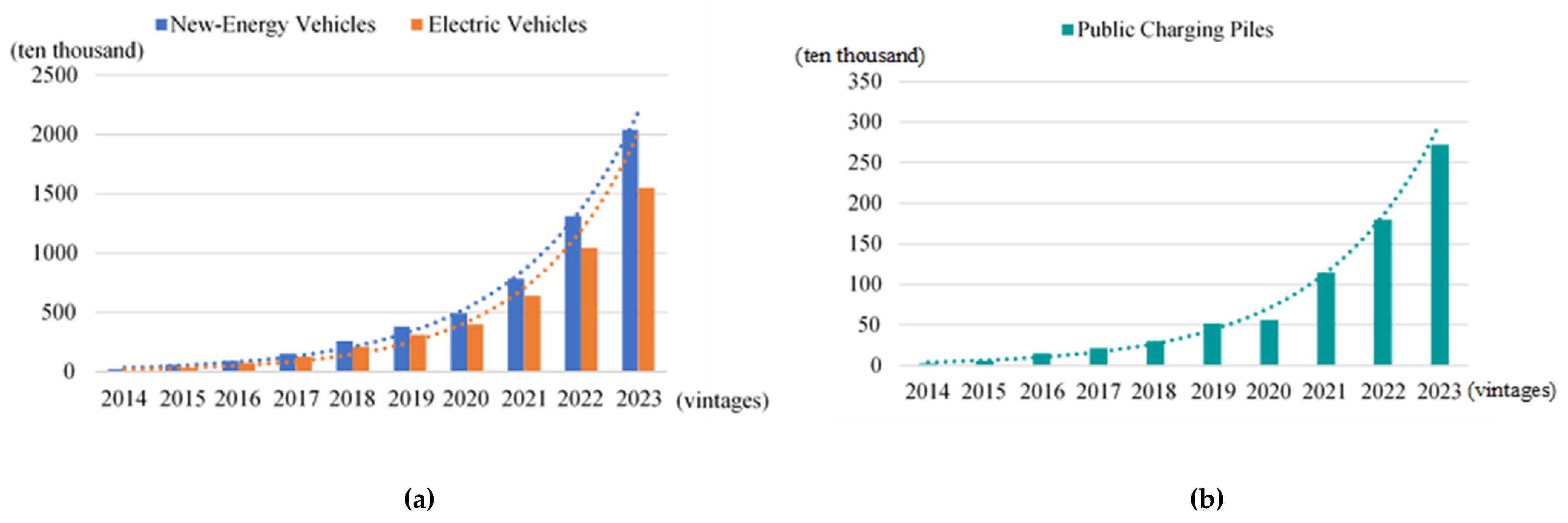





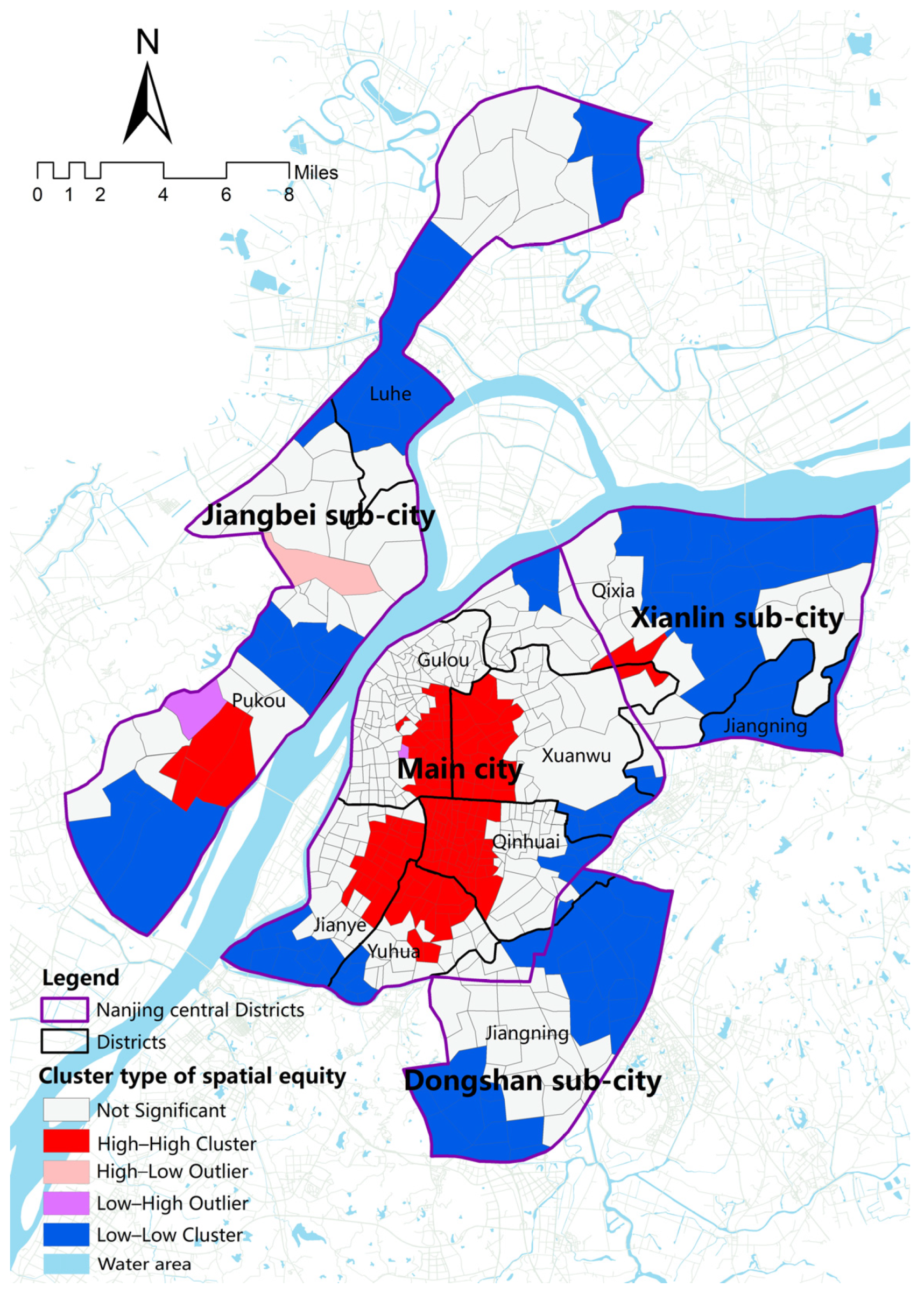
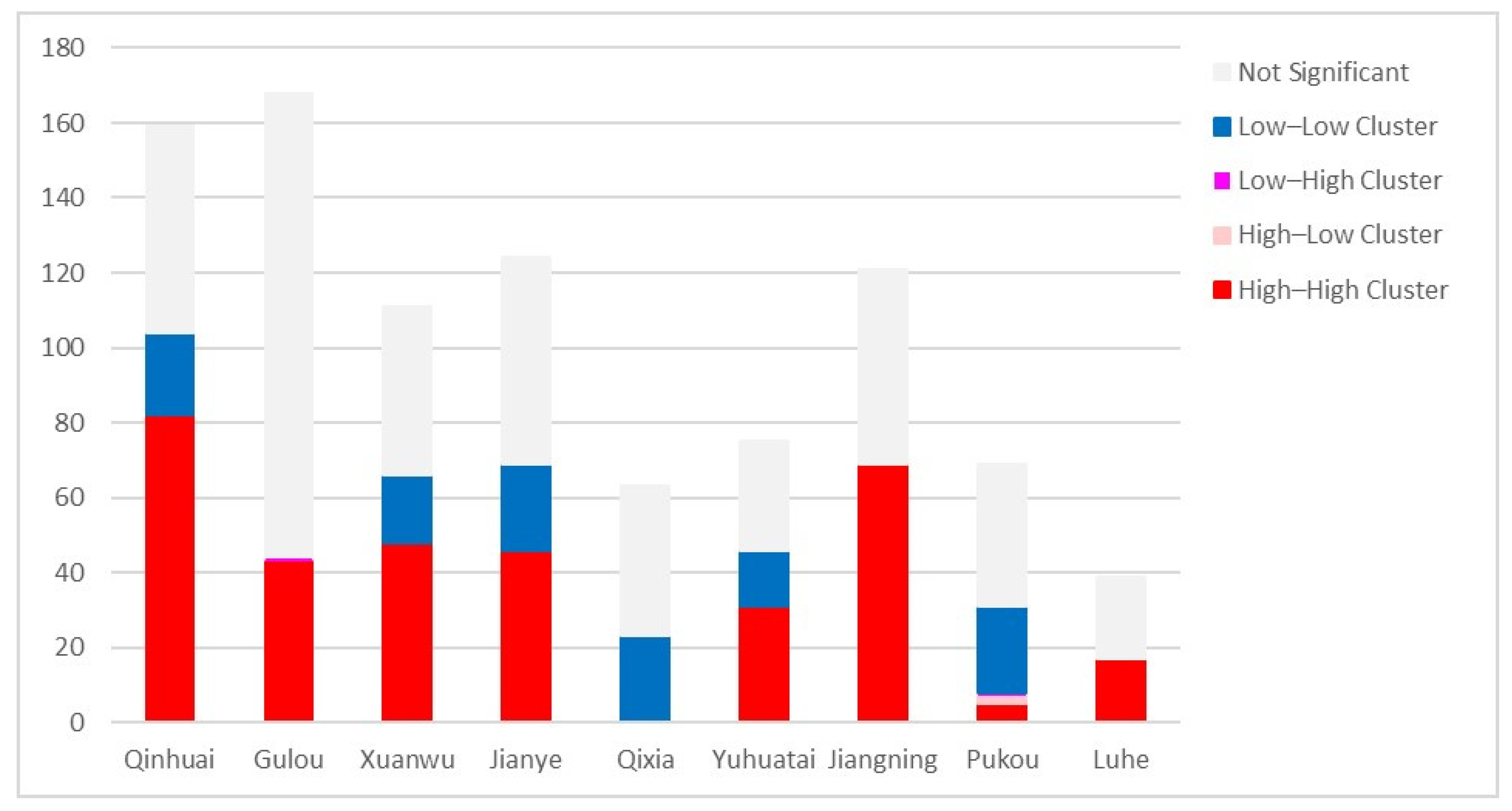

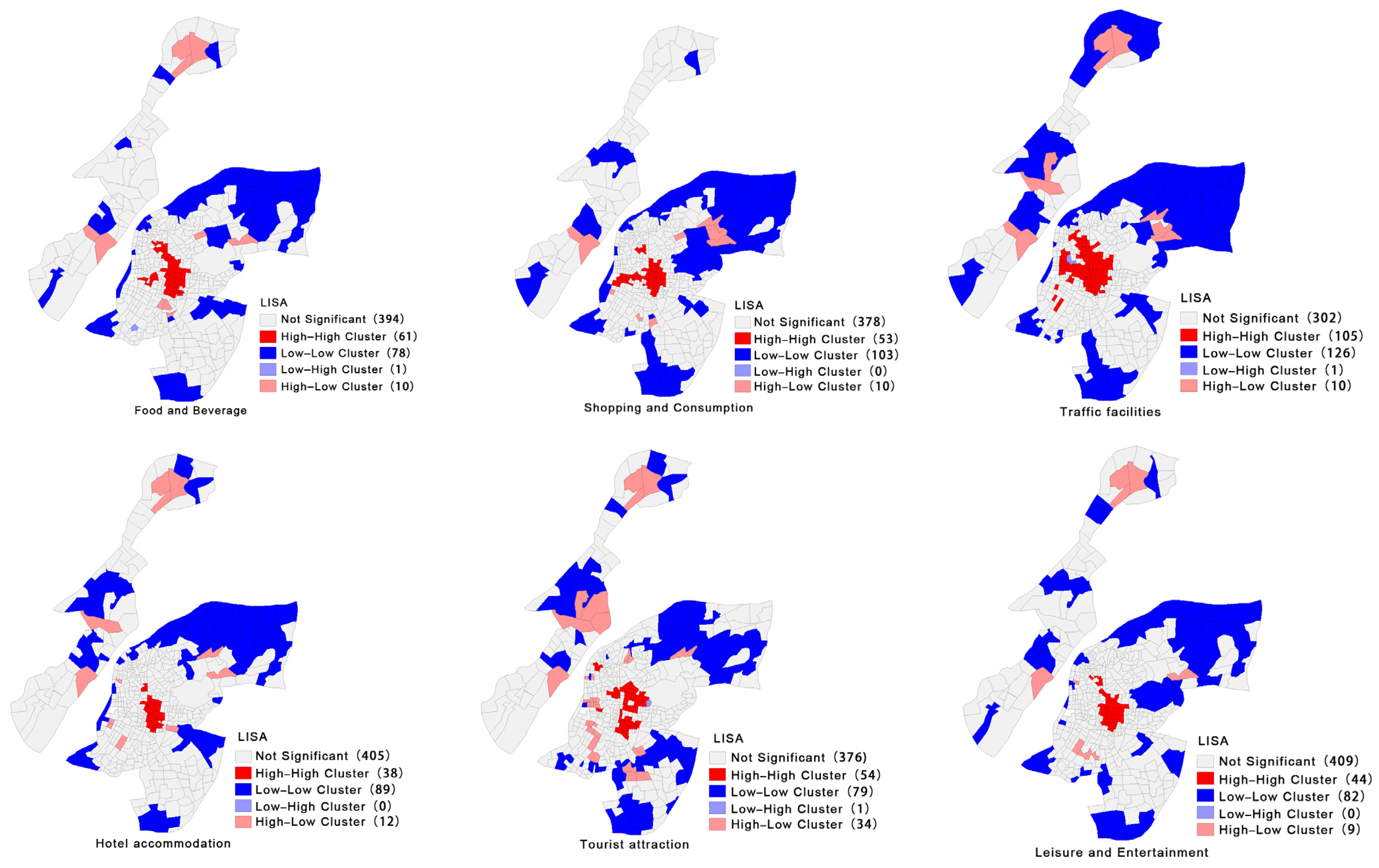
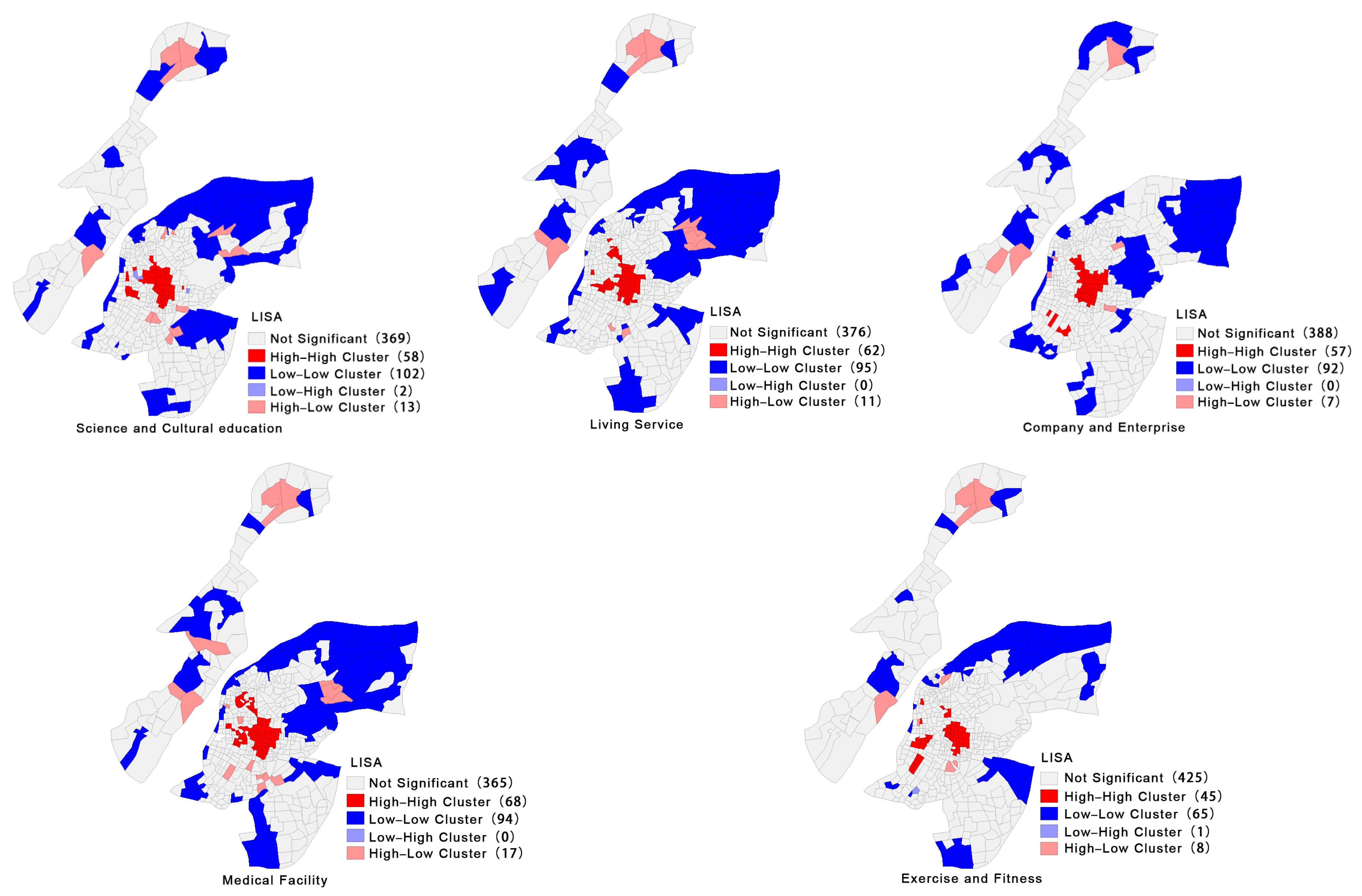
| Vintages | New-Energy Vehicles | Electric Vehicles | Charging Piles |
|---|---|---|---|
| 2014 | 22 | 8 | 2.8 |
| 2015 | 58 | 33 | 5.7 |
| 2016 | 91 | 73 | 15 |
| 2017 | 153 | 125 | 21.4 |
| 2018 | 261 | 211 | 30 |
| 2019 | 381 | 310 | 51.6 |
| 2020 | 492 | 400 | 55.8 |
| 2021 | 784 | 640 | 114.7 |
| 2022 | 1310 | 1045 | 179.7 |
| 2023 | 2041 | 1552 | 272.6 |
| Citation | Research Subjects | Case Study | Methodology |
|---|---|---|---|
| Ghorbanzadeh et al. [42] | Healthcare Facilities | Florida, USA | 2SFCA, ARD |
| Li et al. [9] | EV Charging Services | The top ten cities in China by EVCS | Opportunity-based approach, Global and Local Moran’s I index |
| Zhang et al. [43] | Community-based Service Resources | Nanjing, China | G2SFCA, Local Moran’s I index |
| Chang et al. [45] | Urban Public Facilities | Taiwan, China | Integrated Equity index, Local Moran’s I index |
| Luo et al. [46] | High-speed Rail | China | Theil index |
| Li et al. [44] | Urban Park | Yangzhou, China | 2SFCA, Lorenz Curve and Gini Coefficient |
| Dadashpoor et al. [48] | Urban Facilities | Hamadan, Iranian | SIM model, Density index, Proximity coefficient, AHP |
| Chen et al. [41] | Urban Bus Transit | Edmonton, Canada | DEA model, Lorenz Curves, Gini Coefficient |
| Explanation | |||
|---|---|---|---|
| Dimension | Indicators | Description | |
| Spatial level | Accessibility | Sum of the ratio of service capacity to community demand for charging piles | |
| Availability | Opportunities for users to choose the number and type of charging facilities they use | ||
| Convenience | Inverse of distance to the nearest charging station for users within thresholds | ||
| Affordability | Density of charging posts per neighborhood | ||
| Social level | Community economic indicators | Population | Population density |
| Housing prices | Average price per dwelling unit | ||
| Dwelling age | Date of completion of dwelling | ||
| Community environment indicators | Food and beverage | Restaurants, cafes, etc. | |
| Company and enterprise | Companies, factories, etc. | ||
| Shopping and consumption | Department stores, shopping streets, etc. | ||
| Traffic facilities | Stations, parks, service areas, etc. | ||
| Hotel accommodation | Hotels, guest houses, etc. | ||
| Science and culture education | Schools, libraries, palaces of culture, etc. | ||
| Tourist attraction | Parks, attractions, memorials, etc. | ||
| Living service | Public toilets, baths and saunas, utilities, etc. | ||
| Leisure and entertainment | Cinemas, playgrounds, bars, etc. | ||
| Medical facilities | Hospitals, health centers, etc. | ||
| Exercise and fitness | Ball fields, campgrounds, fitness centers, etc. | ||
| Notation | Description |
|---|---|
| Indices | |
| i | The demand point |
| j | The supply point |
| M | The type of charging post |
| f | The direct current (DC) charging |
| l | The alternating current (AC) charging |
| Parameters | |
| The demand scale at point i | |
| The facility scale at point j | |
| The time from demand point i to supply point j | |
| The threshold time | |
| N | The total number of all charging stations |
| The index of charging stations | |
| The total number of DC charging piles | |
| The total number of AC charging piles | |
| The average numbers of DC charging piles in each community | |
| The average numbers of AC charging piles in each community in Nanjing Central Districts | |
| The variety index of charging stations | |
| The distance from the nearest charging station to i | |
| The minimum distance from demand point I to supply point j | |
| The total number of charging piles | |
| The community population | |
| Variables | |
| The ratio of the number of charging piles in the charging station to the total population in the community | |
| The accessibility of point i | |
| The number of charging stations available at demand point i | |
| The total availability of charging types in community i | |
| The availability index at demand point i | |
| The charging service to community i as the inverse distance of the nearest charging station | |
| The number of piles per capita in community i | |
| The community public charging infrastructure space equity index |
| EVPCI Local Indicators of Spatial Autocorrelation | |||||
|---|---|---|---|---|---|
| Local Moran’s I | Z | p-Value | |||
| Spatial level | Spatial equity | 0.661 | 27.023 | 0.001 | |
| Social level | Community economic indicators | Population density | 0.315 | 16.819 | 0.001 |
| Housing prices | 0.3 | 15.372 | 0.001 | ||
| Dwelling age | 0.014 | 0.7474 | 0.218 | ||
| Community environment indicators | Food and beverage | 0.355 | 17.691 | 0.001 | |
| Company and enterprise | 0.372 | 18.803 | 0.001 | ||
| Shopping and consumption | 0.309 | 15.909 | 0.001 | ||
| Traffic facilities | 0.49 | 23.634 | 0.001 | ||
| Hotel accommodation | 0.268 | 13.687 | 0.001 | ||
| Science and culture education | 0.316 | 16.058 | 0.001 | ||
| Tourist attraction | 0.25 | 13.056 | 0.001 | ||
| Living service | 0.347 | 17.31 | 0.001 | ||
| Leisure and entertainment | 0.3 | 15.152 | 0.001 | ||
| Medical facilities | 0.359 | 18.437 | 0.001 | ||
| Exercise and fitness | 0.247 | 12.746 | 0.001 | ||
Disclaimer/Publisher’s Note: The statements, opinions and data contained in all publications are solely those of the individual author(s) and contributor(s) and not of MDPI and/or the editor(s). MDPI and/or the editor(s) disclaim responsibility for any injury to people or property resulting from any ideas, methods, instructions or products referred to in the content. |
© 2024 by the authors. Licensee MDPI, Basel, Switzerland. This article is an open access article distributed under the terms and conditions of the Creative Commons Attribution (CC BY) license (https://creativecommons.org/licenses/by/4.0/).
Share and Cite
Wang, M.; Liang, Z.; Li, Z. Examining Spatial Disparities in Electric Vehicle Public Charging Infrastructure Distribution Using a Multidimensional Framework in Nanjing, China. ISPRS Int. J. Geo-Inf. 2024, 13, 296. https://doi.org/10.3390/ijgi13080296
Wang M, Liang Z, Li Z. Examining Spatial Disparities in Electric Vehicle Public Charging Infrastructure Distribution Using a Multidimensional Framework in Nanjing, China. ISPRS International Journal of Geo-Information. 2024; 13(8):296. https://doi.org/10.3390/ijgi13080296
Chicago/Turabian StyleWang, Moyan, Zhengyuan Liang, and Zhiming Li. 2024. "Examining Spatial Disparities in Electric Vehicle Public Charging Infrastructure Distribution Using a Multidimensional Framework in Nanjing, China" ISPRS International Journal of Geo-Information 13, no. 8: 296. https://doi.org/10.3390/ijgi13080296






